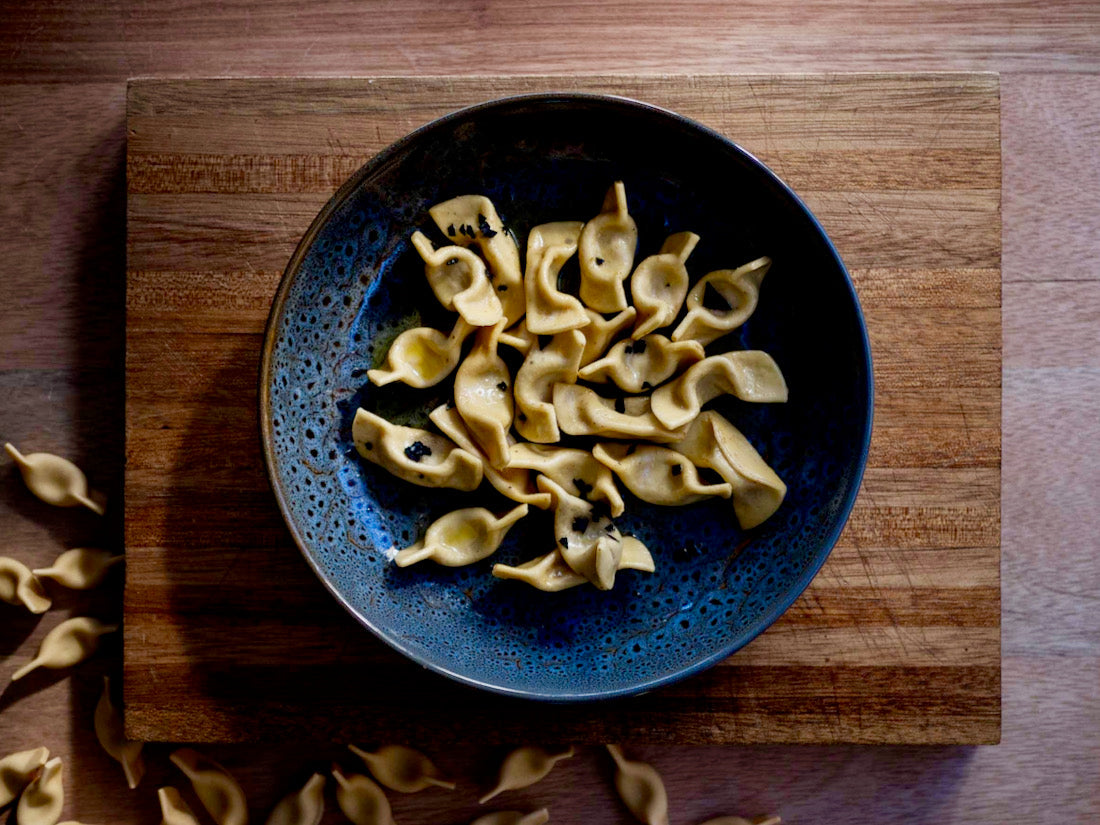
Chestnut Scarpinocc with Sage Brown Butter
|
|
Time to read 4 min
|
|
Time to read 4 min
Despite how often I’m asked, I don’t think that I could pick one favorite shape of pasta. There are some comforting familiars that I grew up making and eating, like ravioli and fettuccine, then there are others that are perfect in the moment, for the sauce or the mood. Every now and then though, there are others again that inspire me through their design. I maintain that if you love good pasta, you love good design!
Scarpinocc are a northern delight, hailing from Lombardy, that I stumbled across long after I’d graduated from Nonna’s “pasta academy.” Despite what she’d warned me about the north, I fell in love. It was a colpo di fulmine (“love at first sight”) of carbs.
These bundles of goodness are a meeting of form and function; a perfect balance of precision and easy efficiency. They start off as essentially mezzalune, sealed semicircles, but are then lazily rolled over onto themselves. With a simple pinch on either side, and a firm poke in the belly, they’re complete. Little Al has particularly pokey fingers, and a penchant for poking pasta, so this is usually his responsibility.
Named for their shoe-like appearance, scarpinocc are traditionally stuffed with a cheesy filling, often featuring taleggio. We’ve added in a handful of chestnuts this time around for a little earthy sweetness, and lightened it with a lump of ricotta.
Adding ricotta is also something that I do almost automatically as a little nod to my Nonna. Every stuffed pasta we made together had ricotta in it. I actually remember her pushing me in my pram (that’s British for “stroller”) to the cheese factory, a good three decades ago, where we’d buy it fresh from the tiny old lady behind the counter. Incidentally, I went back to that factory when I last visited home, and that tiny old lady is still there (though I swear she’s gotten even smaller), still recording purchases with an old notebook and pen. It has to say something about hard work, fresh cheese, and longevity. Anyway, when I can, I add a little ricotta to my pasta, for Nonna!
For a nice and simple finish to this dish, we went with a classic sage brown butter sauce, because sometimes you need to let the pasta speak for itself. We heated the butter and sage in a frying pan until the bubbles disappeared, tossed in our cooked and drained scarpinocc, and then plated up with a scattering of black salt flakes.
To good health and good pasta! Buon appetito,

80 minutes
10 minutes
2-4
150 grams (about 1 ¼ cups) 00 flour
50 grams (about ⅓ cup) semolina flour
2 eggs
2 egg yolks
250 grams (½ pound) chestnuts, raw
150 grams (5¼ ounces) ricotta
50 grams (1¾ ounce) taleggio
25 grams (about 1 ounce) Parmigiano-Reggiano
Cracked pepper, to taste
160 grams (about 10 tablespoons) butter
Large handful of sage leaves
Black salt flakes, to taste
Mix the flours together, form into a well, and then add the eggs and egg yolks into the center. Use a fork or your hand to combine into a shaggy mass.
Knead the dough vigorously for 10 minutes, and then rest for half an hour, sealed in cling wrap and away from direct sunlight and heat. If the dough seems too dry and stiff as you work, simply add a little water. Running your hands under the tap and then continuing to knead without drying them is a great way to add a little moisture without overdoing it.
While the dough rests, prepare the filling. Use a sharp knife to score each of the chestnuts (this will help when it comes time to peel them), and then add them into a pot of cold water. Bring to the boil and cook for 25-30 minutes, until a knife can be easily slid into the flesh.
Drain the chestnuts and remove the skins, then mash together all filling ingredients and load into a piping bag with a medium round tip.
Roll the dough through a pasta machine , turning it through the thickest setting a few times (folding over itself in between passes), before incrementally stepping it through to a medium-thin thickness (on a 9-setting pasta machine, a setting of 6).
Use a round ravioli stamp or cookie cutter, about 6-cm or 2 ¼-inch diameter, to stamp the dough out into circles. Pipe a grape-sized amount of filling into the center of each circle.
To shape the pasta, fold the dough in half over the filling; press gently around the filling to seal. Then roll the filled center of the pasta over so that the dough seam is now located underneath the pasta, off-center. Pinch the ends to seal flat, vertically, then gently poke the top of each piece to form small dimples. Transfer the finished scarpinocc to lightly floured baking paper-lined oven trays. Either cook immediately or refrigerate uncovered for 1-3 days for a little extra chewiness.
Cook the pasta in a large pot of lightly salted boiling water until al dente; no raw dough should be visible when the pasta is cut into. Then prepare the sauce by adding the butter and sage into a medium-hot pan. Heat for 3-4 minutes until the bubbles disappear and the milk solids have begun to brown, and then add the drained pasta directly into the pan. Toss well, and serve with a sprinkle of salt flakes.
Note : Keep any dough that you’re not working on sealed top and bottom in cling wrap to prevent it drying out. If you find that your stamped-out circles are drying before you have the chance to fold them, simply spritz the air above them lightly with water.

